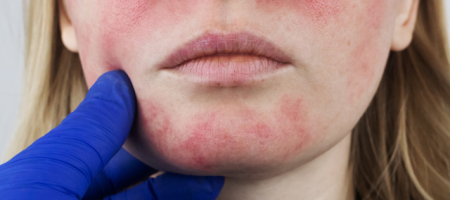Rosacea

Rosacea is a chronic inflammatory syndrome predominantly affecting the central face. It can affect people of all nationalities but is most common in people of Northern European ancestry. It mostly develops between the age of 30–60 years.
Rosacea is very common and is characterised by blushing or flushing, persistent facial redness mostly over the nose cheeks and chin and visible blood vessels in your face (also known as capillaries or telangiectasia). It may also produce small, red and pus-filled bumps (papules and pustules). Signs and symptoms can vary between individuals.
Symptoms
These include:
- Facial blushing or flushing
- Small blood vessels becoming visible over the nose cheeks and chin
- Inflammatory papules and pustules – sometimes mistaken for acne
- Symptoms of Burning/Dryness/Sensitivity
- Eye inflammation
- Facial oedema/Enlargement of the nose (Rhinophyma)
Rosacea is a chronic relapsing condition, which means there are periods when symptoms can flare up but at other times it may go into remission with very few symptoms.
Causes
Rosacea is still incompletely understood. There are several important contributing factors but how these all interact to produce the symptoms and signs in any individual person is still unknown.
Genetic factors – many patients have other affected family members
Environmental factors – Flare-ups might be triggered by:
- Hot drinks and spicy foods which can trigger flushing
- Red wine and other alcoholic beverages
- Temperature extremes especially heat
- Sun exposure
- Strong emotions and stress
- Exercise
- Drugs that dilate blood vessels, including some blood pressure medications
- Some cosmetic, skin or hair care products which may irritate the skin
Biologic factors – alterations in the skin microbiome with an increase of Demodex mites in many patients
There is some evidence that rosacea may be more strongly associated with other conditions such as migraines but these concepts are still evolving.
It is essential that it is correctly diagnosed and distinguished from other conditions that case facial rashes.
Treatments
Although there is no definitive cure for rosacea, symptoms can be very successfully managed through a variety of treatments tailored to each person’s particular signs and symptoms.
A long-term management plan is ideal, although there will be periods when your symptoms improve, and you can stop treatment.
For most people, treatment involves a combination of self-help measures and medication, such as:
- Adherence to a gentle and regular skincare regime with strict sun protection to support the skin barrier function.
- Avoiding known flushing triggers
- Prescriptions creams and gels – medications applied directly to the skin to reduce spots and redness
- Oral medications – tablets or capsules that can help clear up more severe spots, such as oral antibiotics and isotretinoin
Vascular laser and intense pulsed light (IPL) treatment is very helpful for most patients as it works to clear the background redness and reduce the intensity of flushing. This involves beams of light being aimed at the visible blood vessels in the skin to clear them and restore a normal blood vessel network. Generally 2-4 treatments are required with maintenance every 1-2 years.
Resources
For further information, you can visit the following resources:

